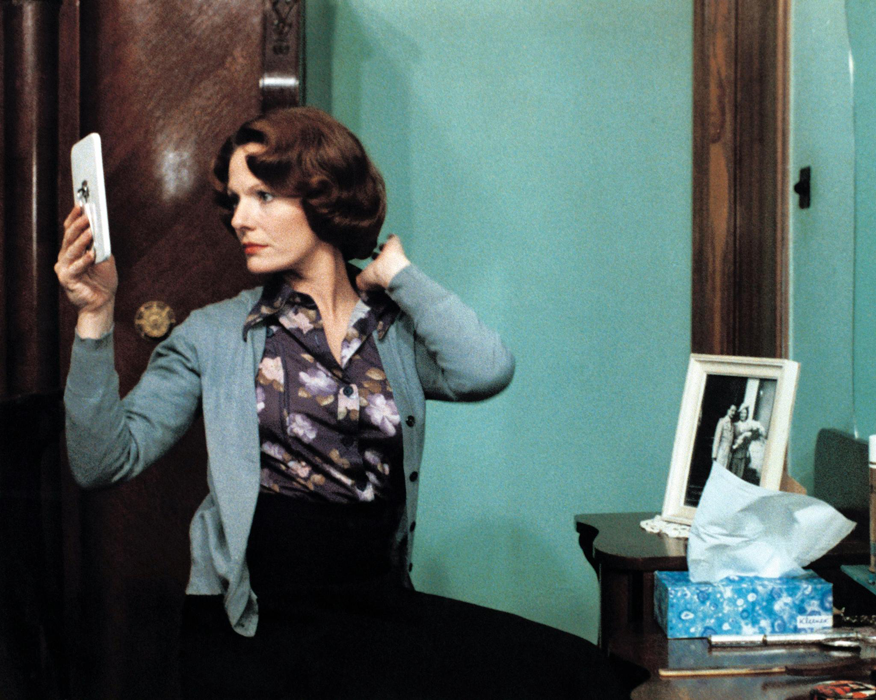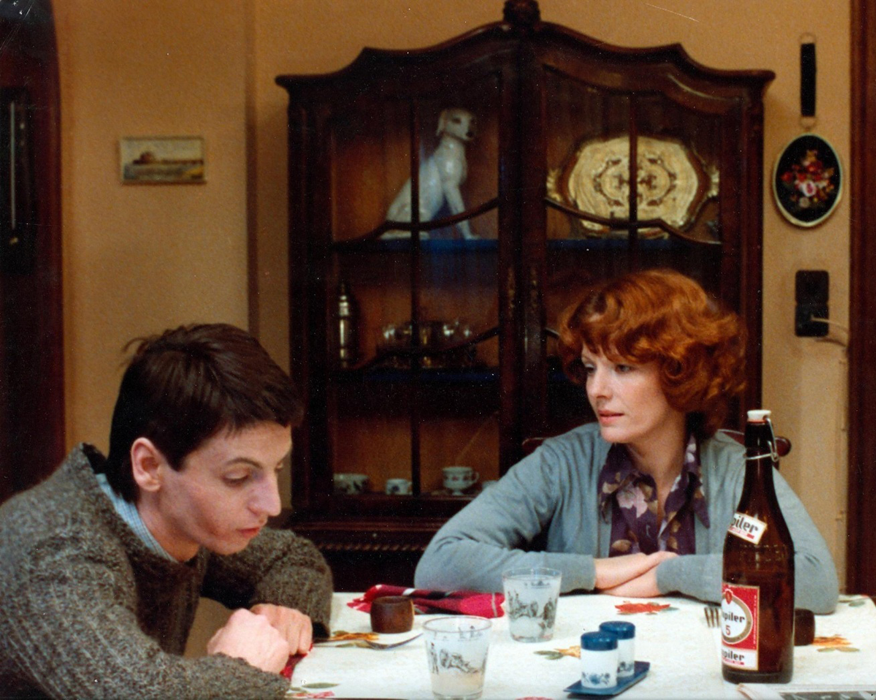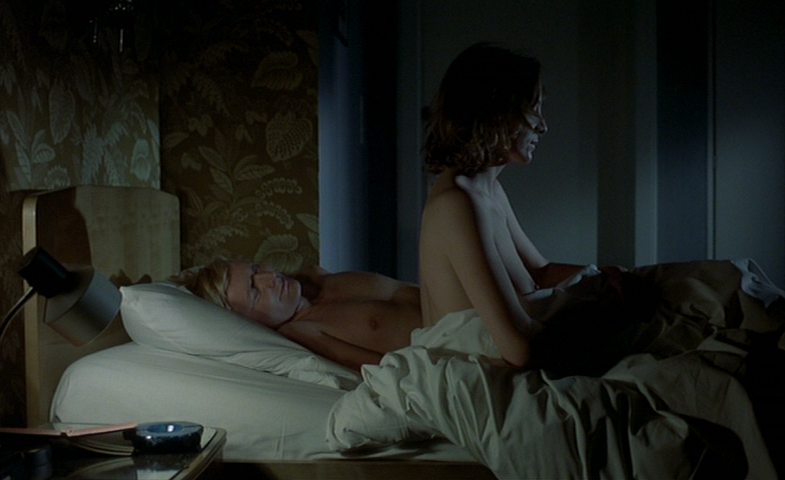A Fetishistic Camera
On the Films of Chantal Akerman
The texts by Flemish writer Daniël Robberechts (1937-1992) bear witness of the impossible task to nevertheless capture the ever changing, impervious reality in words. Hence his predilection for notes and diary fragments. A lot of his work has an intentionally incomplete character, combined with an exceptional precision.
Preoccupied with how the linguistic imagination relates to reality, Robberechts finds an accomplice in Chantal Akerman’s films. In her films, he recognises the tension between artistic strategies and the materiality of everyday reality. An ardent diarist, he also reflects on the autobiographical and documentary value of her films. According to Robberechts, the artwork never quite detaches itself from reality, but unmistakably has an added value: “Lived life is after all only the ‘rough draft’ of the autobiographical text or film which is the composed ‘neat’.”
Paralleling Robberechts’s critical engagement with language at work in his writing, his ‘notes of a naïve spectator’ reach for a cinematographic ontology. What does a film do, what does it do with the spectator, with me? Besides inspiration for observations in art and social criticism, Akerman’s films offer Robberechts a unique aesthetic experience. They open the door to a different experience of reality. Not as ready-made escapism, but as a lucid ‘counter-illusion’.
Bjorn Gabriels
A fetishistic camera. On the films of Chantal Akerman
(Notes of a naïve spectator who’s not even a cinephile. At most, material for a reception-aesthetics of films.)
Up until I saw News from Home and Les rendez-vous d’Anna, I had always felt a camera to be a sadistic instrument. To be photographed means: to be reduced to a defenceless object. My body is congealed on a smaller scale, the perception of the former is stripped down to the visual and moreover, reduced to one single perspective. When photographed, I can be seen without seeing for myself. More so than a wax doll, hair or nail clippings would, a photograph delivers my body to a great number of evil practices. What worries me the most is not the fact that Lewis Carroll photographed young girls, but rather that he himself avoided being photographed at all costs.
In film, the object is often enlarged and this creates the illusion that it can move freely through space. In fact, the object is reduced even stronger by that illusion. The filmed object is trapped in a cage of light; from a kind of belvedere we keep the object within the light cone of our projector.
How come the films of Chantal Akerman demonstrate to me a non-sadistic use of the camera?

1. The intimacy with the object – the subjective object
A filmic intercourse with an inanimate object in time lends subjectivity to that object: Hôtel Monterey, La chambre, News from Home. (And the apartment of Jeanne Dielman, 23 quai du commerce, 1080 Bruxelles may well be an equally important character as ‘Jeanne’ herself, it evokes the terrible events to come, as it were.)
The object is also transformed into subject when the author reveals herself as object, or if she compromises herself with the object. Naturally, this happens each time the author uses autobiographical references. It’s not about knowing whether Chantal Akerman tells us her own life – only her intimates could judge that, and lived life is after all only the ‘rough draft’ of the autobiographical text or film which is the composed ‘neat’. But if I film objects to which I am biographically connected, then I’m especially persuaded and qualified to counter its reduction and flattening which the projection would otherwise cause ‘spontaneously’. (A question of ‘investing’? Comparable to the autobiographical texts in which the writer during the course of his life develops a language that corresponds to his very own desire.)
I can’t help but see in the work of Chantal Akerman a very peculiar kind of ‘documentary realism’. A desire to portray objects very precisely and accurately. It’s not about vraisemblance or (illusory) reality effects –, rather it’s about innuendoes that are controllable for insiders. I don’t know if Jeanne Dielman’s kitchen feels real – for those who have known it, it is astoundingly recognizable. Perhaps it is possible to see Akerman’s films as a venture to portray certain objects correctly and totally. (Brecht: every good poem is also a document.)
But the object’s intimacy doesn’t suffice as an explanation. For example, it doesn’t explain why Le 15/8 doesn’t constitute a sadistic reduction – while Akerman’s intention there was nevertheless hinting at sadism, if we are to believe the author.
2. The resistance against the story
... fetishistic scopophilia, builds up the physical beauty of the object, transforming it into something satisfying in itself. ... voyeurism, on the contrary, has associations with sadism: pleasure lies in ascertaining guilt (immediately associated with castration), asserting control, and subjecting the guilty person through punishment or forgiveness. This sadistic side fits well with narrative. Sadism demands a story, depends on making something happen, forcing a change in another person, a battle of will and strength, victory/defeat, all occurring in a linear time with a beginning and an end. Fetishistic scopophilia, on the other hand, can exist outside linear time as the erotic instinct is focused on the look alone. (Laura Mulvey, ‘Visual Pleasure and Narrative Cinema’, in Screen XVI-3, 1975)
The receiver of a story is always a spectator in a Roman circus: the hero is brought into the arena and subjected to all kinds of challenges. Order-disorder-order, winding-unwinding, desis-lusis, the good against the bad, boy meets girl, Les malheurs de Sophie, Coming and Going, Les infortunes de la vertu. The protagonists are bullets in an arcade game, gravity irresistibly leads them to all kinds of perils. We afford ourselves the luxury of – either sadistically or masochistically – co-experiencing how the protagonists pull through.
In almost all non-commercial films Akerman ignores the story: hers are ‘descriptive’ films where ‘nothing happens’: Hôtel Monterey, La chambre, News from Home. In other films the story is taken to battle. Akerman performs all kinds of transformations on the stereotypes of the story we have been taught to expect, like on a zero degree.
E.g.:
- omission of winding/unwinding by including the old genre of the ‘travelogue’ or travel description;
- omission of causal correlations;
- a systematic avoiding of the ‘idyll’ (noticeable in Je, tu, il, elle but most prominent in Les rendez-vous d’Anna: ‘Anna’ sends ‘Heinrich’ away from her bed but doesn’t ignore him/doesn’t push him aside; against all clichéd expectations, meeting ‘Hans’ in the train doesn’t develop into an idyll; what had to become a lover’s night in Paris is aborted by ‘Daniel’s’ depression.)
Saute ma ville and Jeanne Dielman have more to do with stories. But in the first film the winding [of the narrative] is absent, in the second it’s only visible by way of symptoms: or you could consider as a given for both films that this winding doesn’t exist as an event, but as a continual state preceding the beginning of the work.
This deviation from the sacrosanct stereotype of the story constitutes a heavy sin against dominant culture. Deprived of his stuff, the spectator is frustrated. Chantal Akerman prevents this frustration through a severe and engaging geometrical-musical composition. Notice for example how ‘Anna’ at the start of the film uses communication devices referring to the future, and at the end, a device pointing to the past: the alibiphone.
A story (what we consider, precisely, ‘novelistic’) is a typical product of our civilizations of the soul. Consider Ombredane’s ethnological experiment: a film, La chasse sous-marine, is shown to black students in the Congo and to Belgian students; the former offer a purely descriptive summary of what they have seen, precise, concrete, without affabulation; the latter, on the contrary, betray a great visual indigence, they have difficulty recalling details, they make up a story, seek certain literary effects, try to produce affective states. There is, then, a conflict between the purely optical world of objects and the world of human interiority. (Roland Barthes, ‘Literal Literature’ in Critical Essays, Evanston: Northwestern University Press, 1972, p. 52-53)

3. The time to watch – the persistent gaze
Persisted, non-dramatic sequences do make up ‘the common denominator’ of the films of Chantal Akerman. I’m trying to convey here what I can say with certainty about my experience.
Due to conventional films I’m used to be transported from sequence to sequence so much that ‘I forget that time goes by.’
Here, on the other hand, I’m left to my own devices. I am perceiving by myself. (Impossible not to make mention of the V-effect.1
)
It’s not about solidified images, not about photographs. Sometimes the movements almost go by unnoticed, I lie in wait for any movement. I perceive that I’m watching. I perceive time: both the duration of the shot and the duration of the projection. I come to perceive the screen as a wall (which it is) in front of which I myself have to assume an attitude and a position. I come to find myself on my own and in my own time. I have to determine my own shot, my way of watching and my use of time. If need be I can exercise patience and wait for the next sequence (as one ‘waits for a bus’). But such an attitude renounces enjoyment. I can spend this time much better by watching instead of seeing – and I can watch in such a way that I forget that I’m waiting for something (e.g. for a bus).
Now and then I’m experiencing a hallucinatory counter-illusion: that the object watches back. Everything happens as if Chantal Akerman as an author occupies another position than that usually taken by the author. The author of the conventional film occupies the position of the spectator, tickles him when he has to laugh, hands him a handkerchief when he has to cry, thinks in his place. Chantal Akerman takes sides with the portrayed object.
(One could link these persisted sequences to other cultural phenomena, e.g.:
- repetitive music: “It’s the same, it’s not entirely the same, what changed and when?” and thus with Freud’s repetition compulsion, ‘fort’ and ‘da’;2
- the historiography that disputes history as a collection of facts and events in favour of a history that takes conjunctures and long time spans into account – the longues durées of Fernand Braudel.)
Question 1: Whether the voyeuristic/sadistic gaze really isn’t utterly superficial, fleeting and scattered? It reduces the subject to object, but as opposed to the fetishistic gaze, it’s not at all interested in the object, only in what happens with the object.
Question 2: In what kind of culture did we end up? Socially we almost only perceive each other visually anymore, sight is practically the only sense left for us. (For 500 years already we haven’t been delousing each other anymore, for 200 years we haven’t been allowed to touch each other anymore, we all smell of deodorant...) And in this almost purely visual culture the films of Chantal Akerman reveal that we’re visual illiterates.

PS after watching Les rendez-vous d’Anna for the third time:
1. How obvious the use of persisted sequences is in the end. Because film for the first time enabled us to make moving images, for years on end we’ve only made fast moving images. At first perhaps like children at play with a new toy, later lest the spectator become bored. (Like those clever American novelists who totally screw up their novels as a result of constantly and convulsively trying to ‘keep us in suspense’). Now we are finally acknowledging movement as a possibility rather than as an obligation; now we can show both movement and standstill, both the transition from one to the other, and all relations between them.
2. At the request of her friend ‘Daniel’, ‘Anna’ sings the song ‘La chambre d’hôtel’. Akerman lets Aurore Clément sing the entire song before our eyes. Dominant film aesthetics as a rule would only let us have a résumé of this event: “That will do, the reader understood what happens with this already.” Only: where our experience is concerned such a résumé is of course something entirely different. The résumé differs from the entire event almost as much as the word ‘singing’ differs from the act we indicate with the word ‘singing’.
3. Imagine the impossible for a moment: that films like Les rendez-vous d’Anna achieve the same success and have the same influence as Hollywood productions in their heyday: how differently would we perceive, how differently would we behave, how differently would we live?
- 1Brechtian Verfremdungseffekt.
- 2The game with a wooden toy on a string played by the grandson of Sigmund Freud. While throwing it forward he shouted “fort!” [“gone!”] and while pulling it back “da!” [“there!”]. Freud perceived it as a symbolic scene to come to terms with the disappearance of objects beyond and the reappearance of those objects within the reach of the child, as well as the coming and going of the mother.
‘Een fetisjistische camera. Over de films van Chantal Akerman’ was published in March 1982 in the Flemish literary magazine Heibel.
Many thanks to Kris Latoir, Koen Brams and Cateau Robberechts
Image (1) from Jeanne Dielman, 23, quai du Commerce, 1080 Bruxelles (Chantal Akerman, 1975)
Image (2) from Jeanne Dielman, 23, quai du Commerce, 1080 Bruxelles (Chantal Akerman, 1975)
Image (3) from Les rendez-vous d’Anna (Chantal Akerman, 1978)

